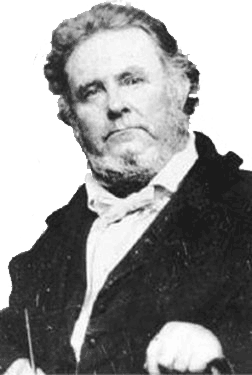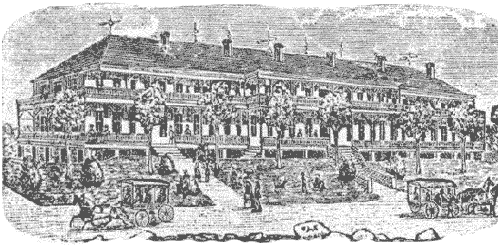"Raymond Years Ago"
By George W. Harper
Journalist - Editor - Owner Of Hinds County Gazette 1845-1883
A Series Published in the Hinds County Gazette, 1878-1879
From the Gillespie Collections edited by Pattie Adams Snowball and Rebecca Blackwell Drake
Home Page
Harper Arrives in Mississippi
Vicksburg & Meridian RR
Businesses in 1844
The Raymond Bar
Early Merchants
1844 Businesses
Seat of Justice
Cotton Industry
Early Churches
Establishment of Schools
John B. Peyton
Raymond Area Homes
Medicinal Resorts & Spas
The Mexican War
Early Churches
Early Schools
Raymond Female Institute
Raymond Military Institute
McNutt-Foote Debate
1844 Presidential Election
Local Elections of 1845
Literary Raymond
Raymond Fires
Old Log Jail
Death of Jos. Stewart
Murder of Benj. Sims
Duel Ends in Death
Raymond & Bolton RR
Harper Elected Mayor
Chaos at Oak Tree Hotel
Great Fire of 1858
Early Area Settlements
-
Amsterdam
-
Yeizer's Store
-
Newtown
-
Meridian Springs
-
Sturgiss Store
-
Dry Grove
-
County Line
Rev. Fisk's Biology Class
Fisk Charged with Fraud
Fleetwood Tragedy
Local Racetracks
Dignitaries Visit Raymond
Winning the Lottery
Fire Company No. 1
"Devoted & Valued Friend"
Tribute to Amos Johnson
Yellow Fever Strikes Raymond
Doctors Treating Victims
Cooper's Well
Mississippi Springs
Newspaper Entrepreneurs
Yankees Sack Gazette Office
Fate of Editorial Giants
Henry Clay Defeated in 1844
Stray Cats in Raymond
"A Remarkable Occurrence"
Blow That Punky Bell to Hell"
Isom Bldgs Destroyed
1851 Gubernatorial Election
Union Ticket Sweeps State
New Raymond Courthouse
Gibbs Building Rebuilt
Hinds Co. Poor House
Schools Struggle
Murder of Addie Owens
War comes to Raymond
The Battle of Raymond
Willie Foote Captured
Make-shift Hospitals
Yankees Occupy Raymond
Raymond Lodge No. 21
Odd-Fellows' Graveyard
Bolls Incarceration
Crimes Blamed on Whisky
Peyton's Willow Tree Prank
Politics in Raymond
Presidential Election 1860
Hinds Co. for Succession
Raymond Fencibles Organized
Churches Reorganize
The Clinton Riot of 1875
Why the Great Uneasiness?
Deaths of Sivley & Thomson
"Kill the Raymond Men"
Harrison Election
Political Gatherings
Event at Dupree's Grove
Presidential Election 1876
Governor Ames Impeached
Great Wrongs Investigated
Fight the Devil with Fire
Reconstruction Era
Harper Ends with Poetic Vision
Part III
Establishment of Schools
In 1844 the Female Academy (in which Miss Coleman now teaches) was about the same building that it is now, with the exception that it was then unfenced. From that day to this it has been occupied for schools, for gospel purposes, and as a dwelling house. Our understanding has always been that the lot was donated to the corporation by Thos, Downing, for a female-school, provided the citizens would erect a suitable building, which arrangement was fully carried into effect by the contracting parties. In 1844 Rev. N. G. North had a fine School there, and, if we are not mistaken, some of the ladies of the town, now some what advanced in years, received their education within those walls, and under the thorough and systematic management of Mr. North who was, probably, one of the best educators of youth that the town has ever had. We can name but seven gentlemen now in Raymond who were citizens of the town when we came here in 1844. They are: G. W. Gibbs, T. I. Hunter, R. S. Drone, Jos. Gray, John Shelton, F. A. R. Wharton, and A. Casper. It is proper to say, however, that J. W. Peyton was then quite a young man, living in his father’s family, just outside of the town; and that our now worthy mayor, J. W. Covington, then lived on a plantation, a few miles from town. Just think of it, the entire grown male population, with the exception of the seven gentlemen named, all gone—gone from Raymond—within thirty-five years.
John B. Peyton
|
In 1844 Maj. John B. Peyton was regarded as the oldest settler of Raymond, and was the most prominent and influential citizen. He resided on what is now known as the “Peyton place” adjoining the town, where he died in 1867. He was a very remarkable man, in many particulars. No man of his time was more intelligent—none had a better judge of men and human nature, we never knew. He came from Virginia to Mississippi at an early period—we believe when Mr. Jefferson was admitted, and assisted in making the first Government surveys that were made in the counties between Adams and Hinds. His home was first in Natchez. With the opening up of this part of the State, he removed to Hinds, and planted for some years near the plantations of Mr. Thos. Wells and the late John F. Watson. He was in the Legislature, from this county, when Jackson was fixed upon as the State Capital by a majority of one vote, and voted for Jackson. He was one of the three Commissioners appointed by the Legislature to discover the geographical centre of Hinds county, and there erected the court house and jail. Where Raymond now stands (which was then a forest of pines) was found to be the centre, and a town was laid out by Maj. Peyton; he purchasing in the mean time, from the government, we believe, the tract of land adjoining the town, to which he soon removed and where he died. Maj. Peyton was a man of enlarged views - of great industry - and enterprise - was a decided Whig in politics - and an ardent lover of his country. He was president of the only Bank that ever did business in Raymond, and was also president of the company that built the Raymond and Bolton railroad in 1840.
|
Raymond was
peculiarly fortunate in 1844 and thereabouts in having a large number of young
men of the very first capacity and standing. No town of the same limited
population, that we have ever known, could equal it - indeed all within our
knowledge have been greatly inferior to old Raymond in this respect. There was
R. N. Downing, W. H. Hampton, S. A.D. Greaves, J. W. Stewart, J. H. Steward,
Frank McNutty, Rives Waddill, F. A. R. Wharton, John Shelton, G. W. Shelton, Dr.
A. Patton, S. H. Thomas, J. M. Watson, Thomas. Mount Jr., and a host of others
and afforded a society that was unsurpassed for brilliancy, and gentility, and
all the other attributes that go to make up true gentlemen and valuable
citizens.
Raymond Area Homes
In 1844 the place on which Mrs. S. M. Moore now resides, just west of the town, was occupied by J. B. Fairchild; further on from the town, on the top of the hill, stood the Conant house, not a vestige of which now remains; while still further on, at the point where the Utica and Cayuga roads fork, stood the Buckles house, a fine two-story frame edifice, which was destroyed by fire 25 or 30 years ago. Beyond the Buckles place, on the Cayuga road, came Jesse Lott’s place, now owned by H. H. Heard, while on the Utica road came John Futch’s place, now owned by Geo. McDonald. On the road towards Clinton, there was no house, that we now remember, between Maj. J. B. Peyton’s and the house occupied until within a few years by J. J. Dromgoole - 5 miles from Raymond. On the road south from Raymond was A. Lynch’s place, then A. H. Bankston’s (now known as the Gray place; and adjoining that was J. W. Covington’s place, by whom now occupied we do not know. On the Jackson road, just outside of town, came Mrs. McGinty’s place (now D. J. Buckley’s,) then old Mr. Bankston’s (now A. G. Adams’,) then a house not now standing occupied by B. G. Bankston, then P. M Alston’s, (not now standing,) then B. G. Sims’, (now H.G. Austin’s,) and then Mississippi Springs.
Medicinal Resorts ¾ Cooper’s Well, Mississippi Springs, Alston Springs
In 1844 the water of Cooper’s Well began to attract attention in the neighborhood. They young people of Raymond the first commenced their visits to the place, and from the small beginning thus made, the Wells soon eclipsed Mississippi Springs; and from about 1848 to 1860 had a most extraordinary run of visitors and had acquired a reputation co-extensive with the Southwest States.
|
Prior to 1844 the pleasure seekers and invalids very generally collected during the summer months at Mississippi Springs. It is said there were often times hundreds of visitors at the Spring at a time, and that some of the most splendid balls and parties—splendid for the array of youth, beauty and fashion—ever witnessed in the State, were presented at the Springs in ’39, ‘40, ’41, &c.
But the Springs was not the only public resort that was captured by the Well. In ’42 and ’43 there was a public house—with bar room, billiards, ten pins and the other attendant circumstances—in a house which stood where the residence of James M. Futch now stands, in the southern part of the town. A spring near the building was held forth as highly mineral, and the sporting men of the town found the place quite an agreeable refuge during the heat of the day as well as after nightfall. In ’44, however, the place was closed as a public resort, and was occupied as a private residence by H. J. Bankston, who started on the premises a brick yard.
All photographs and illustrations were edited into the series by Pattie Snowball and Rebecca Drake.
Copyright © 2008 PattieAdams Snowball, James and Rebecca Drake


